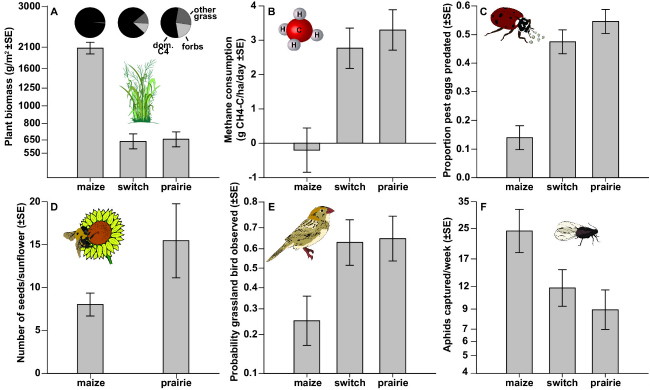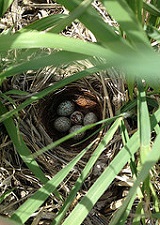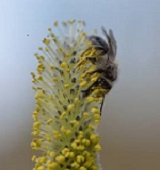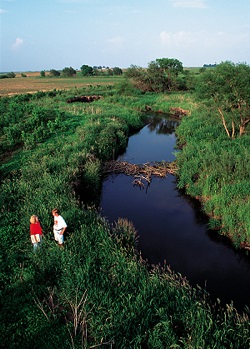Biofuel perennial grass and woody crops provide significant benefits for humankind.

Table of Contents
- What is an Ecosystem Service?
- Perennial Bioenergy Crops Can Provide Exceptional Ecosystems Services
- Ecosystem Services Provided by Perennial Grasses and Woody Crops
- The Economies of Growing Perennial Bioenergy Crops for Ecosystem Services
- Summary
- For More Information
- Contributors to this Summary
What Is an Ecosystem Service?
A functioning ecosystem is the intricate environmental relationship of soil, water, microorganisms, plants, and animals, including humans, working together as a unit. Ecosystem services are the benefits humankind receives, directly and indirectly, from healthy ecosystems.
You probably benefit from a strong ecosystem without giving it a thought or paying a dime. Take a deep breath of fresh air first thing in the morning, then eat a cantaloupe picked from a vine first pollinated by bees. Turn on the faucet to draw a glass of clean water. Drive to work on a well-maintained road not washed out by the latest downpour. Those are the kinds of benefits we call ecosystem services.

Perennial Bioenergy Crops Can Provide Exceptional Ecosystem Services
Often when we imagine healthy, working ecosystems, we think of untouched, natural vegetation. But managed perennial bioenergy crops can also play a role in furnishing important ecosystem services to the environment and to humans.
Currently, annual crops such as corn and soybeans generally enjoy a wider, more profitable set of downstream options in traditional agricultural markets (i.e. human consumption, animal feed, and fuel ethanol) than do perennial bioenergy crops. But many perennial crops, because of their growth behaviors and management practices, often perform comparatively better as providers of beneficial ecosystem services.

Figure 2. Werling, et.al.1 report that key ecological processes varied between maize and perennial grasslands. Variation between maize, switchgrass, and prairie in production of aboveground plant biomass (A), methane consumption by soil methanotrophs (B), predation of pest eggs by beneficial insects (C), pollination of sentinel sunflower plants (maize and prairie only) (D), occurrence of obligate grassland birds (E), and pest aphid pressure (F).

Ecosystem Services Provided by Perennial Grasses and Woody Crops Include:
-
Wildlife habitat enhancement. Native perennial bunchgrasses such as switchgrass provide overhead cover and nesting materials for birds and animals. They are host plants for the larvae of maturing butterflies and moths, and ground-feeding songbirds and gamebirds eat their seeds. They are harvested infrequently, often in the winter, which doesn’t interfere with wildlife breeding cycles.
-
Biodiversity. Perennial grasses and woody crops for biofuels have been shown to provide greater biodiversity than row crops, especially as these crops, in the larger context, diversify the agricultural landscape.
-
 Willow pollinator. Photo: Giuseppe Tumminello, U. Syracuse.
Willow pollinator. Photo: Giuseppe Tumminello, U. Syracuse.Pollination. Perennial grasses offer habitat for a wide range of pollinators such as bees and butterflies; as native plants, they are a good source of nectar and pollen. Shrub willow, for example, is one of the earliest species to flower in the spring, providing nectar for pollinators.
-
Provide biomass fiber that is useful for many bioproducts such as mulch, absorbents and fiberboard.
-
Rural development. Bringing marginal land into use for producing bioenergy crops can help improve the employment prospects and tax bases in rural areas
-
Carbon sequestration. Shrub willow and perennial grasses capture carbon dioxide from the atmosphere and store it in their vast root systems, keeping it out of the atmosphere. This helps curb greenhouse gas emissions. Energy-efficient crops that provide more energy than they use in production, such as perennial grasses and woody crops, also contribute to a reduction in greenhouse gas emissions.
 Riparian buffer. Photo: Lynn Betts, USDA NRCS
Riparian buffer. Photo: Lynn Betts, USDA NRCS -
Erosion control. Land use and conventional agricultural practices have exacerbated soil degradation and erosion. The dense roots and perennial ground cover of perennial bioenergy crops hold the soil in place and help with flood control.
-
Prevention of runoff, especially in sensitive areas such as wetlands and riparian buffer zones. Perennial crops increase water absorption by adding organic matter and aerating the soil through their extensive root systems
-
Reduction of nutrient and chemical loading in surface waters. Bioenergy crops require fewer fertilizer and chemical inputs than most agricultural crops. When grown as a riparian buffer, these perennials filter nonpoint pollution sources.
-
Recreation and scenic beauty.
The Economics of Growing Perennial Bioenergy Crops for Ecosystem Services
While the ecosystem services that a bioenergy crop can provide are extremely valuable to the public in maintaining a healthy, productive, and sustainable environment, they do not have a market value which directly compensates the landowner/farmer.
Production economics for perennial biomass crops are complicated and variable. Equipment, labor, location, and many other factors can strongly influence the cost of production, while end-use markets offer a wide range of prices for the harvested biomass from these crop systems. Some perennial plantings enjoy market success early, while a modeled example for shrub willow shows up a payback time of 13-years.
Perennial crops, therefore, are often considered economically less favorable but environmentally preferred when they are compared to conventional annual crops.
Many of the benefits the public receives from cleaner water, stable soils, scenic beauty, thriving wildlife, and other ecosystem services may seem to be performed for “free,” yet they are still economically valuable. Assigning a value to them and providing a concrete economic incentive for the systems that provide them (such as a perennial crop system), could help bridge the economic gap these crops often face, making them a more viable and compelling choice for farmers. Assigning a value to ecosystem services, however, is very difficult. Many ecosystem services must be measured over long time-scales. In addition, their economic value is often determined by markets that are local and difficult to identify.
But there are efforts to put a value on ecosystem services, including those provided by perennial bioenergy crop systems.
Several government agencies and organizations provide “stewardship incentives” for practices that provide a public benefit and that can be verified. The agencies also promote these practices as a way to improve yields and reduce input costs for landowners.
Here are some examples:
- The USDA Natural Resource Conservation Service’s Conservation Stewardship Program offers financial incentives for best management practices such as biomass planting, pollinator habitat development and cover crops.
- The Farm Service Agency’s Conservation Reserve Program pays landowners to remove environmentally sensitive land from cultivation, and plant it in a long-term ground cover. –
- The U.S. Forest Service’s Stewardship Incentive Program encourages landowners to protect forest wetlands, enhance native vegetation, and plant shelterbelts.
- Some nonprofit organizations, such as The Nature Conservancy, are also beginning to compensate landowners for ecosystem services.
- Metro Vancouver quantifies Ecological System Services in this 2012 video:
Summary
Growing perennial crops for bioenergy can provide public benefits beyond economic returns. Plantings of perennial grasses (such as switchgrass and miscanthus) or woody crops (such as shrub willow and poplar) could have a role in agricultural landscapes as systems that provide ecosystem services that maintain and improve the health and productivity of our environment.
For More Information
- Ecosystems and Human Well-Being: Synthesis, Millennium Ecosystem Assessment (MA). Island Press. 2005
- Perennial grasslands enhance biodiversity and multiple ecosystem services in bioenergy landscapes. Ben P. Werling, et.al. Proceedings National Academy of Sciences. 2014.
- Biodiversity Services and Bioenergy Landscapes: Growing bioenergy crops will transform agricultural landscapes and affect the services they deliver. Ben P. Werling, et.al. Michigan State Extension Bulletin E-3164. 2012.
- Advances in shrub willow crops for bioenergy, renewable products, and environmental benefits, Timothy Volk, et.al. Association of Applied Biologists. 2016.
- Ecosystem Services and Resilience Framework, CGIAR Research Program on Water, Land and Ecosystem Services. 2014.
- Defining Ecosystem Services, Bob Tjaden, University of Maryland Fact Sheet 631.
- Ecosystem Services, Ecological Society of America, ESA.
- Could Bioenergy Perennial Grasses Help Pollinators? CenUSA Blades. 2017.
- Multifunctional Riparian Buffers: Synergies with Bioenergy Crops and Ecosystem Service Provision. Michael Jacobson, NEWBio Webinar. 2017.
Contributors to this Research Summary
Author
- Susan J. Harlow, Freelance Journalist
Peer Reviewer
 The Northeast Woody/Warm-season Biomass Consortium – NEWBio is supported by the Agriculture and Food Research Initiative. This material is based upon work that is supported by the National Institute of Food and Agriculture, U.S. Department of Agriculture, under award number 2012-68005-19703.
The Northeast Woody/Warm-season Biomass Consortium – NEWBio is supported by the Agriculture and Food Research Initiative. This material is based upon work that is supported by the National Institute of Food and Agriculture, U.S. Department of Agriculture, under award number 2012-68005-19703.
Led by Penn State University, NEWBio includes partners from Cornell University, SUNY College of Environmental Science and Forestry, West Virginia University, Delaware State University, Ohio State University, Rutgers University,  USDA’s Eastern Regional Research Center, and DOE’s Oak Ridge National Laboratory and Idaho National Laboratory.
USDA’s Eastern Regional Research Center, and DOE’s Oak Ridge National Laboratory and Idaho National Laboratory.
